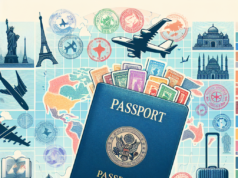
Immigration Court Back Ups: A Growing Problem in the US
The United States of America is a land of immigrants, attracting people from all across the globe to come and build a better life for themselves and their families. In fact, immigration has been a pillar of the American society from its inception, with millions of people making their way to the country every year with hopes of a brighter future. However, the process of immigrating to America is not always as smooth as people would like it to be, with many facing long and arduous legal battles in order to gain a foothold in the country. One of the biggest hurdles that immigrants face is the struggle to navigate the complex immigration court system, which has become increasingly backed up and burdened over the years.
The Immigration Court System
There are currently 69 immigration courts in the US, all of which fall under the jurisdiction of the Executive Office for Immigration Review (EOIR), which is the agency responsible for conducting immigration court proceedings and adjudicating cases. The immigration court system has been established to deal with a variety of legal issues related to immigration, including deportation proceedings, asylum petitions, and removal proceedings. The cases that are processed by the immigration courts are divided into two categories – detained and non-detained.
Non-detained cases involve individuals who are not currently in custody, but have been summoned to appear before an immigration judge in order to have their immigration status reviewed. These cases generally take a longer time to process, as the individuals involved are often living in the community and have more time to prepare their case.
Detained cases, on the other hand, occur when an individual has been taken into custody and is being held in a detention center. These cases are generally prioritized by the immigration courts, as the individuals involved are not free to leave and thus require a speedy decision. However, the majority of cases that come before the immigration courts are non-detained, making up 81% of the total cases that are processed by the system.
Backlogs and Long Wait Times
One of the biggest issues faced by the immigration court system is the growing backlog of cases that are piling up, leading to long wait times and delays for those who are seeking a resolution to their immigration status. According to the Transactional Records Access Clearinghouse (TRAC), which is a research organization that monitors immigration court data, there were over 1.3 million cases pending in the immigration court system as of April 2021, with an average wait time of almost three years for a hearing before a judge. The backlog has been steadily increasing over the years, with some courts facing wait times of up to six years or more.
The impact of this backlog is significant, with many individuals being forced to wait for years in limbo, not knowing whether they will be allowed to stay in the country or not. This has a profound effect on their lives, as they are unable to plan for their future, advance their careers, or build a stable life for themselves and their families. The backlog also puts a strain on the resources of the immigration court system, with judges and court staff being forced to work long hours in an effort to keep up with the demand.
Causes of Backlogs in the Immigration Court System
There are a number of factors that contribute to the backlog of cases in the immigration court system, including:
1. Increased enforcement actions – The current administration has prioritized enforcement actions against immigrants who are living in the country without proper documentation, leading to an increase in the number of cases being processed by the immigration court system.
2. Insufficient resources – The immigration court system has struggled to keep up with the growing demand for its services, with a lack of staff, judges, and resources leading to delays in the processing of cases.
3. Complex legal challenges – The legal system for immigration cases is highly complex, with many different forms of relief available to individuals seeking to stay in the country. This complexity leads to longer processing times and greater backlog of cases.
Solutions to Immigration Court Backlogs
There are a number of solutions that have been proposed in order to address the backlog of cases in the immigration court system, including:
1. Increased funding – One of the biggest challenges facing the immigration court system is a lack of funding, which has led to a shortage of staff and resources. Increasing funding for the system would enable it to process cases more quickly and efficiently, reducing wait times and backlog.
2. Hiring of more judges – The immigration court system has faced a shortage of judges for years, leading to delays in the processing of cases. Hiring more judges would allow the system to handle a greater volume of cases, reducing wait times and backlog.
3. Streamlining the legal system – Simplifying the legal system for immigration cases would enable the court system to process cases more quickly and efficiently, reducing wait times and backlog.
4. Increase in Technology utilization – By leveraging different technologies like Artificial Intelligence and Machine Learning, case processing can be made more efficient and quicker.
Conclusion
The immigration court system is a vital part of the American legal system, providing a forum for individuals seeking to gain legal status in the country. However, the backlog of cases that has built up over the years has put a strain on the resources of the system, leading to long wait times and delays for those seeking resolution. As the immigration debate continues to be an important issue in American politics, it is imperative that efforts be made to address the problem of backlog, and provide a fair and efficient system for those seeking a new life in the United States.
The Bush administration increased the number of cases by hiring new immigration agents and increasing raids in factories and certain communities. This brought the case count up to over 350,000, a record number.
An immigration judge generally shares a law clerk with up to three other judges, as opposed to federal district judges, who each are assigned more than one clerk.
There are under 250 immigration judges. This number has barely changed despite a call by Former Attorney General Alberto R. Gonzales to hire 40 new judges.
Immigration judges are overworked, each handling an estimated 69 hearings a week. Even so, over 180,000 cases were still pending at the end of 2008, another record number.
The backlog of the nation’s immigration costs have left thousands of immigrants questioning their removability from the United States, with some delays lasting up to 5 years.

























